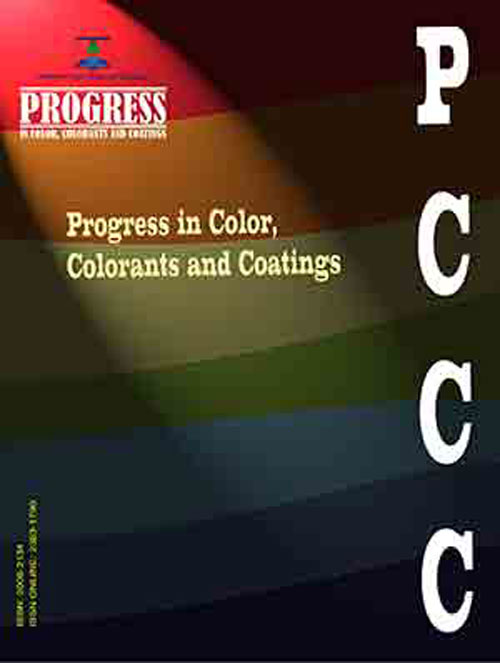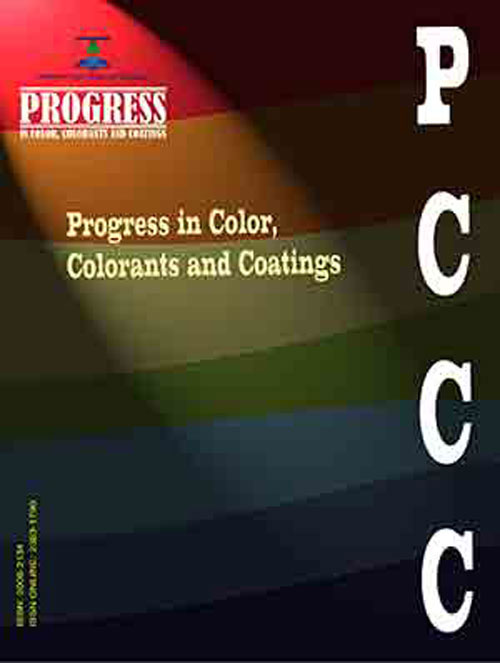فهرست مطالب

Progress in Color, Colorants and Coatings
Volume:13 Issue: 1, winter 2020
- تاریخ انتشار: 1398/10/09
- تعداد عناوین: 6
-
-
Pages 1-10The removal of dyes from wastewater, is one of the major environmental concerns due to their high color density, and they are toxic at even low concentrations. Adsorption process by advanced oxidation processes (AOPs) has been found to be a more effective method than classical methods for treating dye-containing wastewater. This research, is to investigate the decolorization abilities of azo dye in order to treat organic polluted wastewaters efficiently by AOPs. Various operational parameters such as pH, initial dye concentration and catalyst loading were investigated on the use of ZnO/W in the adsorption of Reactive Red 31 (RR 31) dye. The study also focused on the kinetic and thermodynamic investigation such as activation energy (Ea), standard Gibbs free energy (ΔG0), standard enthalpy (ΔH0), and standard entropy (ΔS0). The kinetics of adsorption of dye followed a pseudo-first order kinetic model. Further, thermodynamic study showed that the photocatalytic decolorization of this dye is an endothermic and spontaneous reaction. This study represents a success of thermodynamic for the application in environmental area. Additionally, cost analysis of the process was discussed. The treatment effectiveness was reported as the electrical energy consumed per unit volume (EEO) of waste-water treated required for 100% decolorization of the investigated compound.Keywords: Reactive Red 31, Photocatalysis, Decolorization, Kinetic, Thermodynamic
-
Pages 11-22Nickel base superalloy alloys are used in the manufacture of gas turbine engine components, which in use are exposed to high temperatures and corrosive environments. The platinum aluminide coatings described here have been developed to protect nickel base superalloy alloys from oxidation. In this study, the effect of cyclic oxidation, platinum layer thickness and aluminizing process on behavior of Pt-Aluminide (Pt-Al) coating on nickel-based superalloy Rene®80 have been investigated. For this purpose, after applying different thicknesses of Pt-layer (2, 6 and 8µm), diffusion aluminide coating in two types, high temperature-low activity (HTLA) and low temperature-high activity (LTHA) methods was performed. The results of microstructural investigations by Scanning Electron Microscopy and the X-ray diffraction analysis indicated that coatings include three zones in all thicknesses of the platinum layer and in both methods of aluminizing. The results of cyclic oxidation (1100 °C and 120 cycles) test showed that Pt-Al in all conditions improved the oxidation resistance of Rene®80. The best oxidation resistance is related to the specimen coated with 6 µm Pt by LTHA method, whereas the lowest resistance was related to 2µm Pt in the case of HTLA method. The weight changes during cyclic oxidation of 6µm Pt (LTHA) and 2µm Pt (HTLA) coatings were 3.8 and 6 mg, respectively. Also, the parabolic oxidation rate constants of these coatings were calculated as 1.5*10-12 and 3.8*10-12, respectively.Keywords: Rene®80, Aluminizing, Platinum-Aluminide, Microstructure, Cyclic Oxidation
-
Pages 23-39In this work, an efficient photocatalyst based on gamma-cyclodextrin-modified titanium dioxide nanoparticles (TiO2/γ-CD NPs) was synthesized and used for photocatalytic degradation of rhodamine B (RhB), methyl orange (MO) and methylene blue (MB). The results of FESEM, EDX, TEM, FT-IR, XRD and BET surface area measurement showed that the TiO2 NPs were effectively modified with γ-CD. The photocatalytic properties of the TiO2/γ-CD NPs were evaluated by the degradation of some organic dyes in aqueous solution under ultraviolet (UV) light illumination. The experimental results confirmed that the TiO2/γ-CD had exhibited efficient photocatalytic activities higher than that of the pure TiO2 in the degradation of investigated dyes. The γ-CD could increase the lifetime of the excited states of the unreactive guests and facilitate electron transfer from the excited dye to TiO2 conduction band. The results indicated that the first-order kinetic model well describes the degradation of the dyes by TiO2/γ-CD NPs. the photocatalytic reaction rate constants for RhB, MO and MB dyes in the presence of TiO2/γ-CD NPs were 4, 5.6 and 4.2 times higher than that of pure TiO2, respectively. In addition, the TiO2/γ-CD NPs can be used for several times in real application as an effective photocatalyst.Keywords: TiO2, γ-CD NPs, Photocatalytic degradation, Gamma-cyclodextrin, TiO2 NPs, Surface-modification
-
Pages 41-51The purpose of this study was to obtain the best anthocyanin pigment extract powder from 3 types of drying process, vacuum drying, spray drying, and freeze-drying. The duration and temperature for each type of drying process are 15 h with temperature of 40 oC, 2 h with temperature of 120 oC (inlet) and 60 oC (outlet), 24 h with temperature of -50 oC respectively. This research used the Randomized Block Design method consisting of three treatments with four replications. If there is a significant difference between treatments, the test is continued with the Duncan test. Three drying methods, namely: Treatment A = Vacuum Drying, Treatment B = Spray Drying, Treatment C = Freeze-drying. The Freeze-drying method produces the best characteristics with total anthocyanin 121.63 mg/100 g (DB), color intensity L* (brightness) 64.20, a* (redness) 65.60, b* (yellowness) 18, 52, water content 5.00%, hygroscopicity 12.87%, solubility 97.21%, dissolution time 151 seconds, pH level 2.93, yield 28.69%, and PSA 0.95 µm. Based on the experiment’s result, freeze-drying method was the most suitable parameter for physiochemistry characteristic. It has the highest amount of anthocyanin, the highest antioxidant activity, and the smallest amount of PSA (Particle Size Analyzer).Keywords: Anthocyanin, Drying, Purple sweet potato, Physicochemical Characteristics
-
Pages 53-62Industrial dyeing processes produce a large amount of wastewater that contains many organic compounds such as different type of dyes and pigments, dispersing agents, surfactants which are difficult to treat. Considering that little studies have been done on biodegradation of oil-soluble azo dyes, the lake of this issue is completely felt. In this study, biotreatment of Toluidine Red (TR), an oil-soluble azo dye, was optimized under different environmental conditions. Halomonas strain Gb was capable of decolorizing TR at a pH range of 6.5-9.5 and temperature range of 25-40 °C. The optimum condition was 25 mg/L dye, pH=6.5, temperature 35 °C and 5% (w/v) NaCl. UV-Vis spectrophotometric method, high-performance liquid chromatography (HPLC) and gas chromatography-mass spectrometer (GC-MS) analyses confirmed that biodegradation of TR was accrued successfully. According to the results, Halomonas strain Gb can be recommended as practical bacteria for the treatment of industrial wastewaters containing azo dyes with different water solubility.Keywords: Biotreatment, Dye, Halotolerant, Oil soluble
-
Pages 63-73One of the decisive factors in obtaining the desired properties in coatings is their complete curing, which necessitates the study of kinetics of curing. In recent years, many studies have been conducted on the use of polyhedral oligomeric silsesquioxane (POSS) in coatings. Creating functional groups on POSS and using it in formulation can create new or improve the properties of coatings. In this study, the cure kinetics between hydroxyl functional acrylic resin, aliphatic polyisocyanate and fluorinated POSS with terminal hydroxyl group (F-POSS-OH) was studied using both the Malek and model-free isoconversional method (Flynn-Wall-Ozawa and Kissingere-Akahirae-Sunose) by DSC. The parameters of the cure kinetic equation for both systems were calculated and the effect of F-POSS-OH on the activation energy of polyurethane systems is investigated by free models. The results are shown that the m parameter in the cure kinetic equation for the coatings containing the F-POSS-OH increased, which indicates an increase in the autocatalytic effect of the curing system. Also, in the free model, the F-POSS-OH was reduced the activation energy of reaction.Keywords: Polyhedral oligomeric silsesquioxane (POSS), Fluorinated POSS, Polyurethane, Cure kinetic DSC


